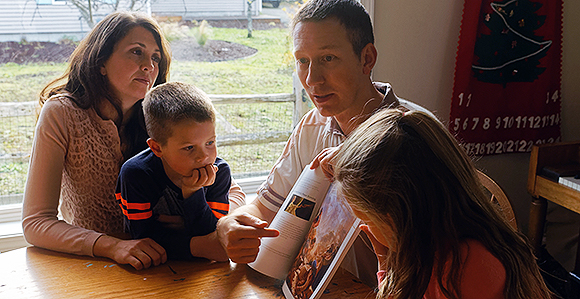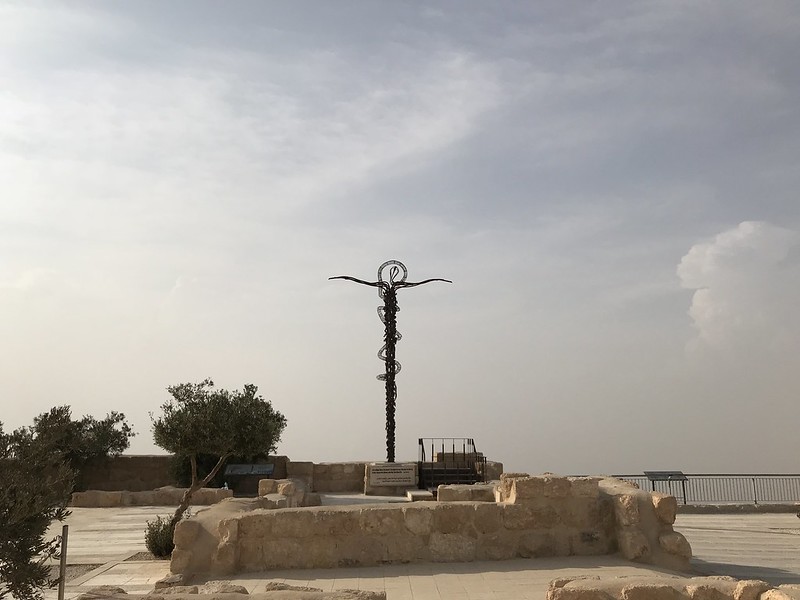What Does a Christ-Centered Life Actually Look Like?
I’ve always enjoyed the accounts in the New Testament of the Savior healing the blind. In his October 2019 conference talk, “The Message, the Meaning, and the Multitude,” Elder Holland recounts one of my favorite stories: a blind man asks passersby about a loud multitude, and when he’s told that the multitude has formed around Christ he insistently asks for the Savior until he is brought before Jesus and healed.
Elder Holland uses this vignette to remind us that our respective “multitudes”—or rather our church meetings, activities, conferences, and trainings—should also center on and turn us toward Christ.
He also reminds us that we are responsible to teach and inform others of the centrality of Christ in our lives and in the restored Church of Jesus Christ of Latter-day Saints. Elder Holland states, “we must find Jesus at the center of it all” and “point past the hustle and bustle and concentrate on . . . the beating heart of the eternal gospel—the love of Heavenly Parents, the atoning gift of a divine Son, [and] the comforting guidance of the Holy Ghost.”
I think this is an excellent talk with an excellent message, but I also pondered what it looks like in my own life to “find Jesus at the center of it all.”
In Elder Holland’s talk, the most explicit example he uses of finding Christ at the center involves a literal, physical Christ literally in the center of a literal multitude. So, what experiences have had that have given me glimpses of what it means to “look past commotion and confusion” and find Christ at the center of my worship and membership in His Church? While Christ might not physically be in our midst, I still believe we can find ways to know Him, access His Atoning power, and follow His example in literal, tangible ways.
Trying to Put Christ at the Center through Come, Follow Me

My first, and perhaps most important point, is that being able to find and recognize Christ at the center of our worship involves a learning curve. My husband and I have enjoyed trying out Come, Follow Me this year, and I have relished the time we’ve spent as a family clumsily eking out the primary lessons for our two-year-old and four-year-old. Our kids especially respond to object lessons (though I sometimes worry that the object of those lessons isn’t quite as clear as I’d hoped!)
During these Come, Follow Me sessions our family has also had some frank conversations about Jesus. And honestly, sometimes these lessons fall flat.
My four-year-old is a very literal child and often has little patience for our explanations. Sometimes when we’ve told him that Jesus loves him, he counters with, “I don’t love Jesus. I don’t know Jesus. Jesus never visits me.” And his questions and confusion make sense.
The analogies we’ve used to clarify the situation haven’t always helped either. My parents currently live in Brazil, and we’ve told our son that Jesus lives far away just like Grandma & Grandpa. We’ve reminded him that Grandma & Grandpa show him that they love him when they call and Skype with us. We’ve told him that we can always talk to Heavenly Father and Jesus through prayer and that we can feel their love through the Spirit. And my son’s take-aways are (logical) questions like, “So, Jesus lives in Brazil?” or “Why doesn’t Jesus Skype me?”
It can be tricky trying to point your child toward “the beating heart of the gospel” when your child expects you to show them an actual beating heart. You know, it would be really convenient and straight-forward if we could video-chat with Jesus, and I feel like it would make my job as a parent a lot easier! But that wouldn’t be very faith-promoting. And as I’ve studied Christ’s life this year in the New Testament, I’ve been reminded that even when Jesus was present as a literal, physical person He was often misunderstood, underestimated, and sometimes not even recognized even by those who knew Him best.
Teaching my son about Christ will continue to require sincere prayer and study on my part. I need to better understand who Christ is and how I can help my son learn about Christ in ways that resonate with him and how his mind works. The ways I’ve learned and gained a testimony of Christ may not be the ways that will work for my son. And that’s okay. I really appreciate how Come, Follow Me has given me a framework for centering gospel learning on Christ while also allowing for and encouraging personal adaptation.
While our gospel learning and teaching should vary according to our unique needs and circumstances, I think 1 Nephi 11 is an excellent example of the circuitous, seemingly improbable connections that can happen to all of us when we strive to place Christ at the center of our endeavors and teaching goals.
In 1 Nephi 11, Nephi is “caught away in the Spirit of the Lord” after he’s pondering Lehi’s vision of the tree of life. Nephi’s vision starts out with Spirit showing Nephi the same tree Lehi saw and then asking Nephi what he wants to know. Nephi tells the Spirit that he wants to understand what the tree represents and means.
Instead of directly answering, the Spirit shows Nephi the city of Nazareth and a pregnant Mary and asks Nephi about the “condescension of God.” Nephi doesn’t know what this means and again the Spirit doesn’t answer this question directly. Instead, the Spirit tells Nephi that Mary is the earthly mother of Christ. The Spirit shows Nephi a vision of Mary again, but this time she’s holding baby Jesus in her arms.
The Spirit then tells Nephi that this baby is the “Lamb of God, yea, even the Son of the Eternal.” And then, finally, the Spirit asks Nephi if he now knows the meaning of “the tree which [Lehi] saw”? And miraculously, Nephi does! By teaching Nephi about Christ and pointing to Him as the “center of all things” Nephi is able to figure out that the tree of life represents the “love of God.”
Even after reading this account very carefully, how exactly Nephi understands the symbolism of the tree is unclear to me. It seems like a logical leap. What it is remarkably clear, however, is how important it is for the Spirit to direct Nephi to the meaning of all things, which is Christ. Throughout the rest of the vision, the Spirit continues to reveal more about Christ and through his increased knowledge of Christ, Nephi is able to receive illumination and clarity not only about the meaning of Lehi’s dream, but his role in keeping the records that will become part of the Book of Mormon, and how he and his descendants fit into the larger plan God has for the world.
I think that finding and placing Christ at the center of all things means looking for the big picture and eternal perspective even when it doesn’t feel like looking at the big picture will fix or provide clarity for the stress and difficulties we’re currently experiencing. Yet, when we focus on studying the Savior and understanding His purpose, we can often find unexpected clarity and guidance on the very issues that we’ve had to step back from. It’s a beautiful, and not always intuitive process, but one that requires faith that Christ is the center.
In that vein, I’d like to share two personal experiences that have, perhaps a little improbably, turned me toward Christ and helped me better understand His nature and place in my life.
The Perfect Missionary

Right after my husband and I were married we moved to Connecticut for eight months so my husband could complete an internship. While we were there, I worked as a substitute teacher and private tutor trying to scrounge up some supplemental income.
For about four months I tutored a sweet eight-year-old boy with his reading. I’d meet with him twice a week in his home, and I’d have nice chats with his mom afterward. Around this time, my husband and I were also feeding the missionaries regularly and they were always challenging us to be better member missionaries. So, I’d been praying about who I could help and talk to, and I decided I was going to be more open and transparent about my beliefs during these biweekly conversations with this boy’s mother.
She’d ask me questions about Utah and Brigham Young University (where I was going to graduate school), and I thought I was doing a pretty good job casually but effectively bringing up my beliefs. I even invited her to a few of our church activities and events, and though she’d always politely refuse my invitations it was always cordial and I was feeling proud of my efforts.
And then on the last day of tutoring before I returned to Utah, the boy’s mother presented me with a going-away gift: a bottle of wine and a wine glass with the inscription “Girls Just Wanna Have Wine.” And the final nail in the coffin was that name of the wine was super lewd (I’m under impression that this was very cheap wine). The boy’s mom was like, “Thanks so much for everything you’ve done! You’re always working so hard; I hope you can use this to take a night off and relax a little.”
Well. I didn’t really know what to say. I was just like “Alright, great, thanks so much!” and I walked back to my car. And as I sat in my car I thought, “Wow, while I’m no stranger to experiencing failure in sundry ways, it has never been so . . . hilarious.” And then I laughed all the way home and not even in a crazy, despairing sort of way. And I had a good laugh about it with my husband too.
As I’ve pondered this experience, it’s been so instructive for me in how I approach failure and has helped me gain understanding into the personal nature of Christ’s Atonement. You see, I really love when things are funny, and I greatly appreciate irony, cleverness, and sardonic humor. But I am also the kind of person to beat myself up for not being righteous enough, and I’ve given myself real guilt-trips when my church lessons weren’t up to par or when I never seemed to have any of the “Ensign moments” where people have joined the church or gotten some amazing life insight because of my good example or timely invitation.
This moment felt like a personalized gift for me from God: a hilarious, ridiculous object lesson that made me feel okay about failure.
Did Jesus inspire this nice mother to thoughtfully gift me some crudely named wine? I’m not sure I’d go there. But it’s been one of the experiences in my life that’s most effectively shown me that it’s okay not to be perfect and that our Heavenly Father doesn’t expect perfection from us right now.
Obviously, I was not an effective member missionary in this circumstance. Yet, it was the first time I can remember feeling real happiness and even confidence within the context of failure! I knew Heavenly Father was still pleased with me and my efforts, and I also knew He expected me to keep trying and improve. From an outside perspective, this personal experience doesn’t intuitively point to Christ, yet it’s been so instructive in my personal quest of how to be more confident in my efforts to share the gospel, serve in the Church, and access Christ’s Atonement.
A Little Miracle in Jordan

My second example is a bit more conventional but has also helped me understand how to find Christ in moments we might not expect. And, appropriately for this talk, it involves Elder Holland. When I was eight years old, my family lived in Amman, Jordan, and attended a small branch. The church wasn’t officially recognized in Jordan and Elder Holland, who had recently been called as an apostle, had been assigned to visit Jordan and do some diplomacy-like things for the Church.
He was also going to offer a special prayer for the land of Jordan and all our branch members were invited to attend. My dad couldn’t take off work, but my mom was excited about this unique spiritual opportunity. So, even though she was worried about going alone with all us kids—at that time my older brother was 10, I was 8, and my younger brothers were 4 and 2—she loaded us into the Mazda and drove us the hour to Mt. Nebo where Elder Holland was going to offer the prayer.
In sum, what my Mom had hoped would be a spiritual and uplifting experience, one that seemingly offered the perfect recipe for “centering on Christ” (we were in Jordan where Christ had literally walked, we were on the Mt. Nebo, and an Apostle of Jesus Christ was offering a super special prayer) actually turned out to be embarrassing and frustrating.
My baby brothers immediately started fussing, my mom actually fell down part of the hill in her efforts to calm my brothers, and then she ended up having to stand too far away to even hear much of the prayer. She also spent the whole prayer feeling guilty that she and her kids were being such a distraction to everyone else.
My mom had gone to this event because she was trying to put Christ at the center of her life, and instead, she felt disheartened and mortified. But two things helped salvage the moment: before he began his prayer Elder Holland turned to our branch president and told him to make sure to record every single member in attendance and mentioned very specifically to not forget to record the names of the children who were present.
And then, after the prayer, when my Mom was fleeing to our van as quickly as possible, the branch president caught up to her and said, “Thank you so much for coming. And thank you for bringing your children.”
My mother’s experience resonates with me so much more now that I have small children of my own. There will be times in our lives when we will feel that our current circumstances make it hard or even impossible for us to find Christ or feel His love in the ways we want to. Or we may believe that there is so much commotion and tumult in our own lives (and maybe not even bad commotion, just normal family, work, and life commotion!), that finding or communing with Christ is out of our reach.
But good Christlike leaders, loving friends, and wonderful members of our community can step in and help point us to Christ with their own acts of kindness and inclusion. My Mom didn’t find Christ that day where she expected to find Him—in the solemn prayer and symbolism of the moment—but she found Him in the thoughtfulness and love of His servants.
I think that in many ways we are all like the blind men and women in the New Testament. We seek Christ because we need His Atonement to heal us and allow us to truly see who He is. I believe that Christ is at the center of our Church: The Church of Jesus Christ of Latter-day Saints.
Sometimes we may be frustrated in our journey to find him, and sometimes we may find him in places we don’t expect. But I have felt His presence and His love enough to know that He is at the center—whatever “the center” means and looks like for you. I’d like to close by echoing Elder Holland’s beautifully put admonition that “through the incessant din and drumbeat of our day, may we strive to see Christ at the center of our lives.”
 Kelsey Smith Gillespie is an aspiring hiker and gardener who is most often found wrangling her young progeny. She also works as an adjunct English instructor at Brigham Young University.
Kelsey Smith Gillespie is an aspiring hiker and gardener who is most often found wrangling her young progeny. She also works as an adjunct English instructor at Brigham Young University.


